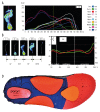Use of 3D-Printed Heel Support Insoles Based on Arch Lift Improves Foot Pressure Distribution in Healthy People
- PMID: 31549689
- PMCID: PMC6777389
- DOI: 10.12659/MSM.918763
Use of 3D-Printed Heel Support Insoles Based on Arch Lift Improves Foot Pressure Distribution in Healthy People
Abstract
BACKGROUND 3D-printed insoles are widely used. This study was conducted to test a customized three-dimensional (3D)-printed heel support insole based on arch lift and to investigate whether the pressure distribution on the sole was improved while maintaining foot function. MATERIAL AND METHODS The design was based on a 3D plantar contour scanning modeling technique. Thirty healthy male participants walked along a 10-m track under 3 self-controlled interventions. A customized 3D-printed heel support insole based on arch lift was inserted into the socks for the experimental condition A. For condition B, a customized 3D-printed heel-supporting insole was inserted into the socks, and a standardized pre-made heel-supporting insole was inserted into the socks as a control (condition C). We used the Footscan® pressure plate to measure the plantar parameters in the forefoot contact and foot flange phases in each condition. RESULTS Compared with condition B and the control condition, the peak pressure under the heel was significantly lower in condition A (P<0.05), and the peak pressure in the midfoot region was not significantly increased (P>0.05). CONCLUSIONS The biomechanical properties of the customized 3D-printed heel support are better than those of the traditional heel support insole, especially when there is a need for an additional increase in heel height. Patients do not decrease midfoot motion function while using this customized insole.
Conflict of interest statement
None.
Figures






Similar articles
-
An optimized design of in-shoe heel lifts reduces plantar pressure of healthy males.Gait Posture. 2016 Jun;47:43-7. doi: 10.1016/j.gaitpost.2016.04.003. Epub 2016 Apr 13. Gait Posture. 2016. PMID: 27264401
-
Comparative Study of the Effects of Customized 3D printed insole and Prefabricated Insole on Plantar Pressure and Comfort in Patients with Symptomatic Flatfoot.Med Sci Monit. 2019 May 12;25:3510-3519. doi: 10.12659/MSM.916975. Med Sci Monit. 2019. PMID: 31079137 Free PMC article.
-
The Effects of Short-Term Wearing of Customized 3D Printed Single-Sided Lateral Wedge Insoles on Lower Limbs in Healthy Males: A Randomized Controlled Trial.Med Sci Monit. 2019 Oct 15;25:7720-7727. doi: 10.12659/MSM.919400. Med Sci Monit. 2019. PMID: 31611547 Free PMC article. Clinical Trial.
-
Effect of 3D printed insoles for people with flatfeet: A systematic review.Assist Technol. 2023 Mar 4;35(2):169-179. doi: 10.1080/10400435.2022.2105438. Epub 2022 Aug 24. Assist Technol. 2023. PMID: 35882078
-
Comparative Efficacy of 3D-Printed Insoles in Managing Common Foot Conditions: A Review.Med Sci Monit. 2025 Feb 12;31:e947252. doi: 10.12659/MSM.947252. Med Sci Monit. 2025. PMID: 39935114 Free PMC article. Review.
Cited by
-
A Three-Dimensional Printed Foot Orthosis for Flexible Flatfoot: An Exploratory Biomechanical Study on Arch Support Reinforcement and Undercut.Materials (Basel). 2021 Sep 14;14(18):5297. doi: 10.3390/ma14185297. Materials (Basel). 2021. PMID: 34576526 Free PMC article.
-
The Upper Limb Orthosis in the Rehabilitation of Stroke Patients: The Role of 3D Printing.Bioengineering (Basel). 2023 Oct 27;10(11):1256. doi: 10.3390/bioengineering10111256. Bioengineering (Basel). 2023. PMID: 38002380 Free PMC article. Review.
-
Design and Preliminary Validation of Individual Customized Insole for Adults with Flexible Flatfeet Based on the Plantar Pressure Redistribution.Sensors (Basel). 2021 Mar 4;21(5):1780. doi: 10.3390/s21051780. Sensors (Basel). 2021. PMID: 33806449 Free PMC article.
-
Effects of Custom-made Insoles on Plantar Biomechanics and Upper Extremity Muscle Performance.Curr Med Sci. 2022 Feb;42(1):159-168. doi: 10.1007/s11596-021-2471-6. Epub 2021 Nov 30. Curr Med Sci. 2022. PMID: 34846699
-
3D Printing of Individual Running Insoles - A Case Study.Orthop Res Rev. 2023 May 29;15:105-118. doi: 10.2147/ORR.S399624. eCollection 2023. Orthop Res Rev. 2023. PMID: 37275301 Free PMC article.
References
-
- Caudell GM. Insertional achilles tendinopathy. Clin Podiatr Med Surg. 2017;34:195–205. - PubMed
-
- Palmanovich E, Ayalon M, Sira DB, et al. The effect of eliminating leg length difference on plantar foot pressure distribution in patients wearing forefoot offloading shoe. Foot (Edinb) 2017;33:39–43. - PubMed
-
- Salvioli S, Guidi M, Marcotulli G. The effectiveness of conservative, non-pharmacological treatment, of plantar heel pain: A systematic review with meta-analysis. Foot (Edinb) 2017;33:57–67. - PubMed
-
- Zhang X, Li B, Hu K, et al. Adding an arch support to a heel lift improves stability and comfort during gait. Gait Posture. 2017;58:94–97. - PubMed
MeSH terms
LinkOut - more resources
Full Text Sources

